Chenyang Li
Vibration-Based Energy Metric for Restoring Needle Alignment in Autonomous Robotic Ultrasound
Aug 09, 2025Abstract:Precise needle alignment is essential for percutaneous needle insertion in robotic ultrasound-guided procedures. However, inherent challenges such as speckle noise, needle-like artifacts, and low image resolution make robust needle detection difficult, particularly when visibility is reduced or lost. In this paper, we propose a method to restore needle alignment when the ultrasound imaging plane and the needle insertion plane are misaligned. Unlike many existing approaches that rely heavily on needle visibility in ultrasound images, our method uses a more robust feature by periodically vibrating the needle using a mechanical system. Specifically, we propose a vibration-based energy metric that remains effective even when the needle is fully out of plane. Using this metric, we develop a control strategy to reposition the ultrasound probe in response to misalignments between the imaging plane and the needle insertion plane in both translation and rotation. Experiments conducted on ex-vivo porcine tissue samples using a dual-arm robotic ultrasound-guided needle insertion system demonstrate the effectiveness of the proposed approach. The experimental results show the translational error of 0.41$\pm$0.27 mm and the rotational error of 0.51$\pm$0.19 degrees.
PIVOTS: Aligning unseen Structures using Preoperative to Intraoperative Volume-To-Surface Registration for Liver Navigation
Jul 27, 2025
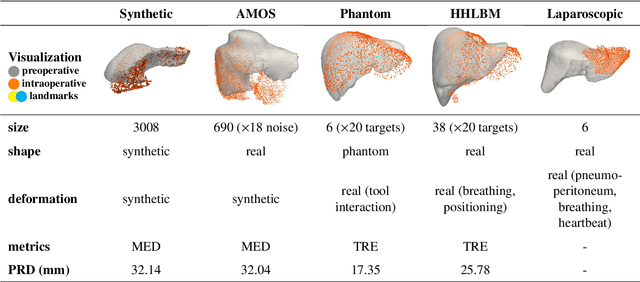
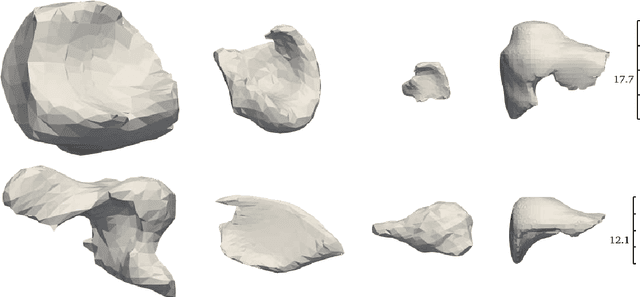
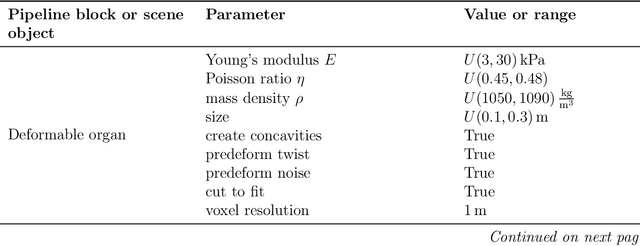
Abstract:Non-rigid registration is essential for Augmented Reality guided laparoscopic liver surgery by fusing preoperative information, such as tumor location and vascular structures, into the limited intraoperative view, thereby enhancing surgical navigation. A prerequisite is the accurate prediction of intraoperative liver deformation which remains highly challenging due to factors such as large deformation caused by pneumoperitoneum, respiration and tool interaction as well as noisy intraoperative data, and limited field of view due to occlusion and constrained camera movement. To address these challenges, we introduce PIVOTS, a Preoperative to Intraoperative VOlume-To-Surface registration neural network that directly takes point clouds as input for deformation prediction. The geometric feature extraction encoder allows multi-resolution feature extraction, and the decoder, comprising novel deformation aware cross attention modules, enables pre- and intraoperative information interaction and accurate multi-level displacement prediction. We train the neural network on synthetic data simulated from a biomechanical simulation pipeline and validate its performance on both synthetic and real datasets. Results demonstrate superior registration performance of our method compared to baseline methods, exhibiting strong robustness against high amounts of noise, large deformation, and various levels of intraoperative visibility. We publish the training and test sets as evaluation benchmarks and call for a fair comparison of liver registration methods with volume-to-surface data. Code and datasets are available here https://github.com/pengliu-nct/PIVOTS.
DAM-GT: Dual Positional Encoding-Based Attention Masking Graph Transformer for Node Classification
May 23, 2025Abstract:Neighborhood-aware tokenized graph Transformers have recently shown great potential for node classification tasks. Despite their effectiveness, our in-depth analysis of neighborhood tokens reveals two critical limitations in the existing paradigm. First, current neighborhood token generation methods fail to adequately capture attribute correlations within a neighborhood. Second, the conventional self-attention mechanism suffers from attention diversion when processing neighborhood tokens, where high-hop neighborhoods receive disproportionate focus, severely disrupting information interactions between the target node and its neighborhood tokens. To address these challenges, we propose DAM-GT, Dual positional encoding-based Attention Masking graph Transformer. DAM-GT introduces a novel dual positional encoding scheme that incorporates attribute-aware encoding via an attribute clustering strategy, effectively preserving node correlations in both topological and attribute spaces. In addition, DAM-GT formulates a new attention mechanism with a simple yet effective masking strategy to guide interactions between target nodes and their neighborhood tokens, overcoming the issue of attention diversion. Extensive experiments on various graphs with different homophily levels as well as different scales demonstrate that DAM-GT consistently outperforms state-of-the-art methods in node classification tasks.
SU-YOLO: Spiking Neural Network for Efficient Underwater Object Detection
Mar 31, 2025Abstract:Underwater object detection is critical for oceanic research and industrial safety inspections. However, the complex optical environment and the limited resources of underwater equipment pose significant challenges to achieving high accuracy and low power consumption. To address these issues, we propose Spiking Underwater YOLO (SU-YOLO), a Spiking Neural Network (SNN) model. Leveraging the lightweight and energy-efficient properties of SNNs, SU-YOLO incorporates a novel spike-based underwater image denoising method based solely on integer addition, which enhances the quality of feature maps with minimal computational overhead. In addition, we introduce Separated Batch Normalization (SeBN), a technique that normalizes feature maps independently across multiple time steps and is optimized for integration with residual structures to capture the temporal dynamics of SNNs more effectively. The redesigned spiking residual blocks integrate the Cross Stage Partial Network (CSPNet) with the YOLO architecture to mitigate spike degradation and enhance the model's feature extraction capabilities. Experimental results on URPC2019 underwater dataset demonstrate that SU-YOLO achieves mAP of 78.8% with 6.97M parameters and an energy consumption of 2.98 mJ, surpassing mainstream SNN models in both detection accuracy and computational efficiency. These results underscore the potential of SNNs for engineering applications. The code is available in https://github.com/lwxfight/snn-underwater.
DeepOFormer: Deep Operator Learning with Domain-informed Features for Fatigue Life Prediction
Mar 28, 2025
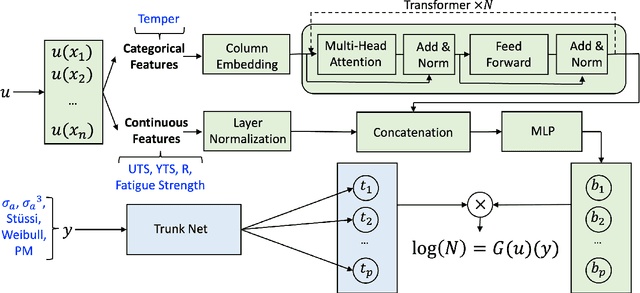
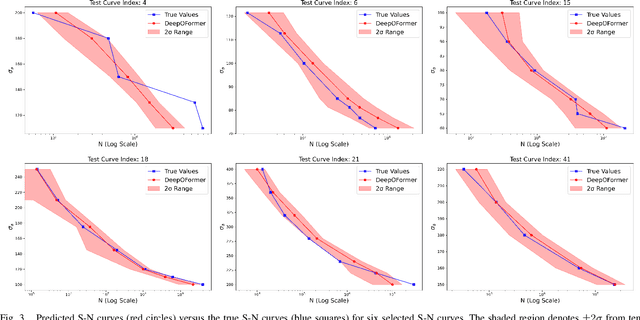
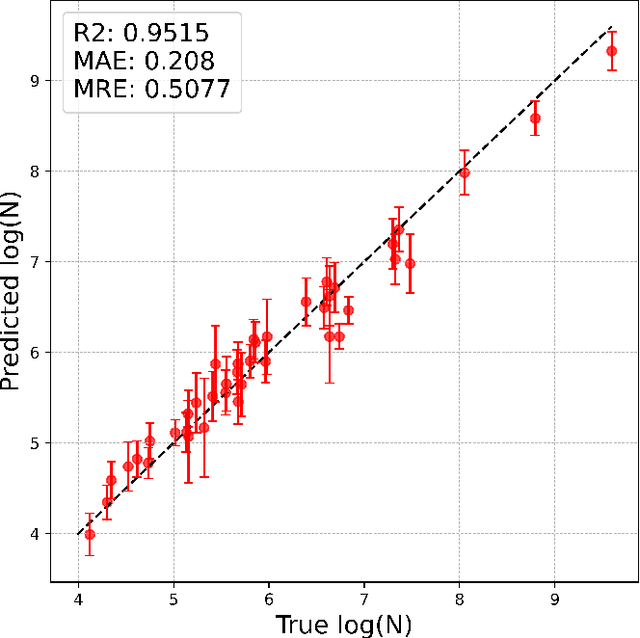
Abstract:Fatigue life characterizes the duration a material can function before failure under specific environmental conditions, and is traditionally assessed using stress-life (S-N) curves. While machine learning and deep learning offer promising results for fatigue life prediction, they face the overfitting challenge because of the small size of fatigue experimental data in specific materials. To address this challenge, we propose, DeepOFormer, by formulating S-N curve prediction as an operator learning problem. DeepOFormer improves the deep operator learning framework with a transformer-based encoder and a mean L2 relative error loss function. We also consider Stussi, Weibull, and Pascual and Meeker (PM) features as domain-informed features. These features are motivated by empirical fatigue models. To evaluate the performance of our DeepOFormer, we compare it with different deep learning models and XGBoost on a dataset with 54 S-N curves of aluminum alloys. With seven different aluminum alloys selected for testing, our DeepOFormer achieves an R2 of 0.9515, a mean absolute error of 0.2080, and a mean relative error of 0.5077, significantly outperforming state-of-the-art deep/machine learning methods including DeepONet, TabTransformer, and XGBoost, etc. The results highlight that our Deep0Former integrating with domain-informed features substantially improves prediction accuracy and generalization capabilities for fatigue life prediction in aluminum alloys.
When Can We Solve the Weighted Low Rank Approximation Problem in Truly Subquadratic Time?
Feb 24, 2025Abstract:The weighted low-rank approximation problem is a fundamental numerical linear algebra problem and has many applications in machine learning. Given a $n \times n$ weight matrix $W$ and a $n \times n$ matrix $A$, the goal is to find two low-rank matrices $U, V \in \mathbb{R}^{n \times k}$ such that the cost of $\| W \circ (U V^\top - A) \|_F^2$ is minimized. Previous work has to pay $\Omega(n^2)$ time when matrices $A$ and $W$ are dense, e.g., having $\Omega(n^2)$ non-zero entries. In this work, we show that there is a certain regime, even if $A$ and $W$ are dense, we can still hope to solve the weighted low-rank approximation problem in almost linear $n^{1+o(1)}$ time.
Rethinking Tokenized Graph Transformers for Node Classification
Feb 12, 2025Abstract:Node tokenized graph Transformers (GTs) have shown promising performance in node classification. The generation of token sequences is the key module in existing tokenized GTs which transforms the input graph into token sequences, facilitating the node representation learning via Transformer. In this paper, we observe that the generations of token sequences in existing GTs only focus on the first-order neighbors on the constructed similarity graphs, which leads to the limited usage of nodes to generate diverse token sequences, further restricting the potential of tokenized GTs for node classification. To this end, we propose a new method termed SwapGT. SwapGT first introduces a novel token swapping operation based on the characteristics of token sequences that fully leverages the semantic relevance of nodes to generate more informative token sequences. Then, SwapGT leverages a Transformer-based backbone to learn node representations from the generated token sequences. Moreover, SwapGT develops a center alignment loss to constrain the representation learning from multiple token sequences, further enhancing the model performance. Extensive empirical results on various datasets showcase the superiority of SwapGT for node classification.
Fusion of Millimeter-wave Radar and Pulse Oximeter Data for Low-burden Diagnosis of Obstructive Sleep Apnea-Hypopnea Syndrome
Jan 25, 2025



Abstract:Objective: The aim of the study is to develop a novel method for improved diagnosis of obstructive sleep apnea-hypopnea syndrome (OSAHS) in clinical or home settings, with the focus on achieving diagnostic performance comparable to the gold-standard polysomnography (PSG) with significantly reduced monitoring burden. Methods: We propose a method using millimeter-wave radar and pulse oximeter for OSAHS diagnosis (ROSA). It contains a sleep apnea-hypopnea events (SAE) detection network, which directly predicts the temporal localization of SAE, and a sleep staging network, which predicts the sleep stages throughout the night, based on radar signals. It also fuses oxygen saturation (SpO2) information from the pulse oximeter to adjust the score of SAE detected by radar. Results: Experimental results on a real-world dataset (>800 hours of overnight recordings, 100 subjects) demonstrated high agreement (ICC=0.9870) on apnea-hypopnea index (AHI) between ROSA and PSG. ROSA also exhibited excellent diagnostic performance, exceeding 90% in accuracy across AHI diagnostic thresholds of 5, 15 and 30 events/h. Conclusion: ROSA improves diagnostic accuracy by fusing millimeter-wave radar and pulse oximeter data. It provides a reliable and low-burden solution for OSAHS diagnosis. Significance: ROSA addresses the limitations of high complexity and monitoring burden associated with traditional PSG. The high accuracy and low burden of ROSA show its potential to improve the accessibility of OSAHS diagnosis among population.
MapExpert: Online HD Map Construction with Simple and Efficient Sparse Map Element Expert
Dec 17, 2024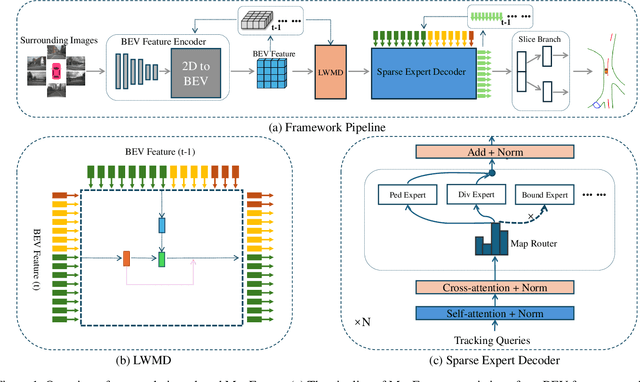



Abstract:Constructing online High-Definition (HD) maps is crucial for the static environment perception of autonomous driving systems (ADS). Existing solutions typically attempt to detect vectorized HD map elements with unified models; however, these methods often overlook the distinct characteristics of different non-cubic map elements, making accurate distinction challenging. To address these issues, we introduce an expert-based online HD map method, termed MapExpert. MapExpert utilizes sparse experts, distributed by our routers, to describe various non-cubic map elements accurately. Additionally, we propose an auxiliary balance loss function to distribute the load evenly across experts. Furthermore, we theoretically analyze the limitations of prevalent bird's-eye view (BEV) feature temporal fusion methods and introduce an efficient temporal fusion module called Learnable Weighted Moving Descentage. This module effectively integrates relevant historical information into the final BEV features. Combined with an enhanced slice head branch, the proposed MapExpert achieves state-of-the-art performance and maintains good efficiency on both nuScenes and Argoverse2 datasets.
Fundamental Limits of Prompt Tuning Transformers: Universality, Capacity and Efficiency
Nov 25, 2024Abstract:We investigate the statistical and computational limits of prompt tuning for transformer-based foundation models. Our key contributions are prompt tuning on \textit{single-head} transformers with only a \textit{single} self-attention layer: (i) is universal, and (ii) supports efficient (even almost-linear time) algorithms under the Strong Exponential Time Hypothesis (SETH). Statistically, we prove that prompt tuning on such simplest possible transformers are universal approximators for sequence-to-sequence Lipschitz functions. In addition, we provide an exponential-in-$dL$ and -in-$(1/\epsilon)$ lower bound on the required soft-prompt tokens for prompt tuning to memorize any dataset with 1-layer, 1-head transformers. Computationally, we identify a phase transition in the efficiency of prompt tuning, determined by the norm of the \textit{soft-prompt-induced} keys and queries, and provide an upper bound criterion. Beyond this criterion, no sub-quadratic (efficient) algorithm for prompt tuning exists under SETH. Within this criterion, we showcase our theory by proving the existence of almost-linear time prompt tuning inference algorithms. These fundamental limits provide important necessary conditions for designing expressive and efficient prompt tuning methods for practitioners.
 Add to Chrome
Add to Chrome Add to Firefox
Add to Firefox Add to Edge
Add to Edge